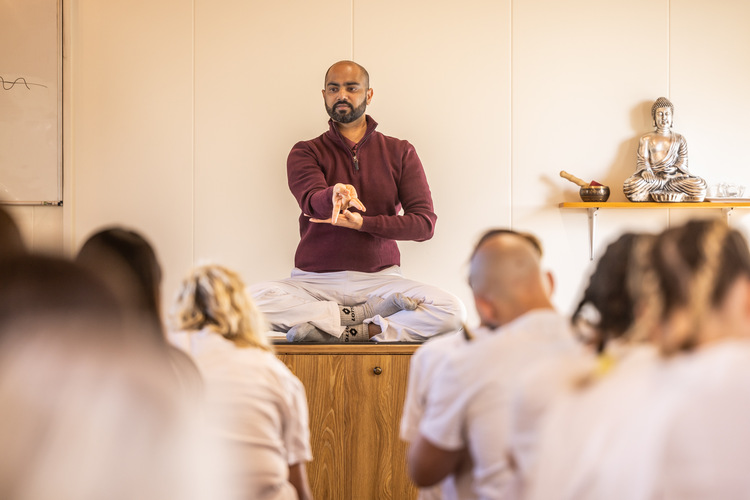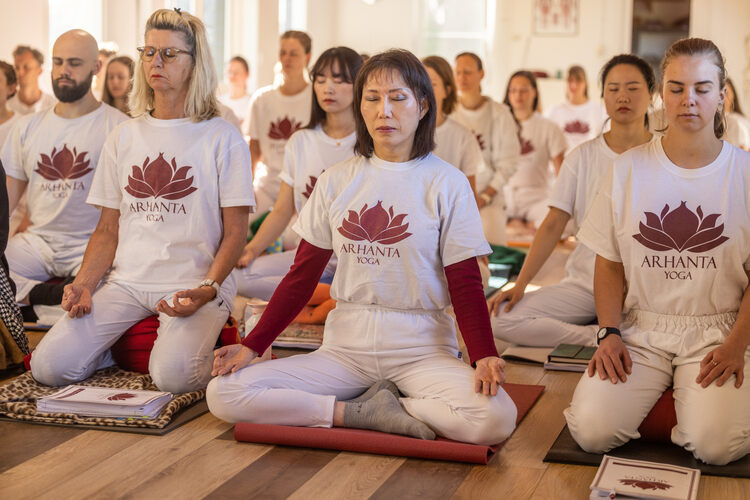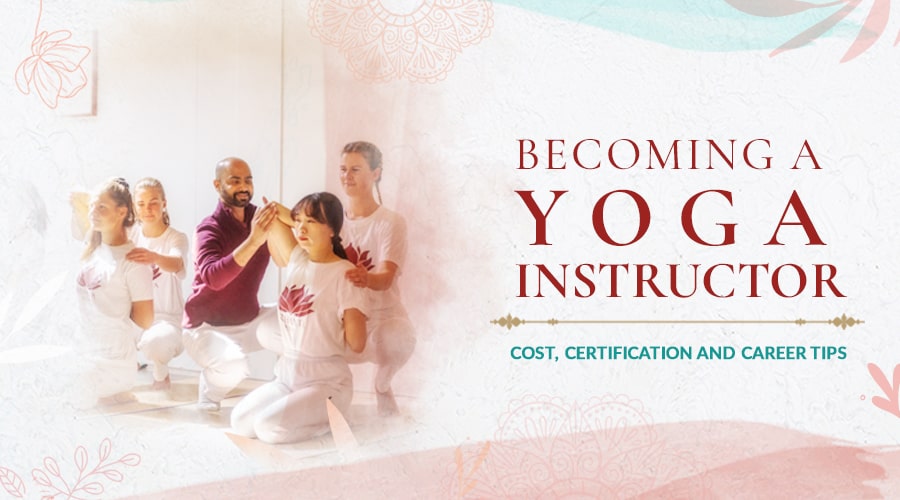Becoming a yoga instructor is a life-changing career choice. While delving deeper into your own practice, it also allows you to share your passion with others and help people find balance in their lives through yoga.
But before you can leap into this new career, there are several questions you'll need to ask yourself: 'How much does a yoga instructor training cost?' 'What kind of courses will I need to take?' and 'What can I expect in terms of salary and career opportunities?' Although it might seem overwhelming initially, don't let the many unknowns deter you. You can become a skilled and confident yoga instructor with some guidance and determination.
This blog will answer all these questions and more, providing an in-depth guide on how to become a yoga instructor. So whether you're just starting to explore this career path or you've already taken the first step, here is everything you need to know to make your dream career a reality.
Who Can Become a Yoga Instructor?
Anyone can become a yoga instructor as long as they have the passion and are willing to put in the time, effort, and training to teach professionally. While teaching yoga is open to everyone, yoga instructors must have a certain amount of experience and meet a few basic requirements. These include:
- A well-rounded understanding of the principles and practices of yoga (asanas)
- Leadership and communication skills
It's also important to note that the desire to learn and teach yoga always outweighs experience. Another prerequisite skill for yoga training, therefore, must be patience. Trust in the process, be gentle to yourself and never lose sight of your goal, especially when times get tough. These trials and tribulations set good yoga instructors apart from great ones.
What Does a Yoga Instructor Do?

There's more to being a yoga instructor than teaching asanas and adjusting postures. A yoga instructor is responsible for leading yoga classes and helping students improve their physical, mental, and spiritual well-being through yoga. An ordinary week of a yoga instructor can consist of the following duties and responsibilities:
- Plan and teach yoga classes that are appropriate for the level and abilities of the students in the class.
- Create a safe and supportive environment for students to practice yoga.
- Continuously educate themselves on new techniques, practices, and evolving knowledge in the yoga field.
- Build relationships with students and create a community atmosphere in the studio.
- Promote the studio and attract new students.
How to Become a Certified Yoga Instructor?
Becoming a yoga instructor is a continuous journey, but along the way, you will receive a wealth of knowledge and experience. Most yoga schools require you to complete a 200-hour yoga teacher training course and obtain a yoga instructor certificate to teach professionally. As a result, there are numerous ashram and online training programs with daily support that make getting certified much easier.
Here is a basic breakdown of the steps you will need to take to become a certified yoga instructor.
Step 1: Develop Your Yoga Practice
Before enrolling in a yoga teacher training program, take time to deepen your practice and improve your physical fitness and flexibility. You can join a yoga studio, follow video tutorials online, or even join a short beginner's yoga course. This is also an excellent opportunity to explore different styles of yoga and find out which interest you most.
Step 2: Find the Right Training Program
Look for programs that align with your personal beliefs and preferred yoga style. If you're looking for an authentic yoga training, studying in India offers a truly unique experience. There are plenty of online teacher training programs for practitioners that don't have the time or funds to study abroad. Remember to check that reputable organizations like the Yoga Alliance USA accredit your course. This will ensure that your yoga teacher training course meets the international standards set out by the alliance.

Step 3: Enroll & Complete a Yoga Teacher Training Program
Once you have found a program, enroll and complete the training. The duration of the program can vary from a few weeks to several months, depending on the program you choose. However, 200 hours of training is considered the minimum training required before you can start teaching. If you plan on teaching abroad, it's a good idea to register with a reputed yoga association and get insurance.
Step 4: Continue Educating Yourself
Many organizations require continuing education to maintain certification status, and it's also essential to stay up-to-date with new trends and techniques in the yoga world. 50- and 100-hour courses are advised for follow-up training after completing a 200-hour yoga teacher training. These shorter courses also allow you to explore other styles of yoga such as Prenatal Yoga, as well as meditation, and pranayama practices.
How Much Does It Cost to Become a Yoga Instructor?
At a traditional yoga ashram, a 200-hour yoga instructor training costs anywhere from €1950 to €2250 and up, depending on the room and location you choose. The course fee typically includes all tuition fees, accommodation during the training, three meals a day, course manual and study materials, and in some cases, airport or train transfers.
If a traditional ashram training is out of your budget, some yoga schools offer flexible online teacher training programs at a reduced price of around €1450. With online training, you not only save on additional expenses like airfare and travel costs, but you can also study from home or work at a pace that suits you.
Also, it's worth noting that some teachers offer payment plans or scholarships, so be sure to inquire about any financial assistance options. At Arhanta Yoga, for example, we have a three installment plan available for those students who cannot pay the total amount upfront.

Get a free copy of our Amazon bestselling book directly into your inbox!
Learn how to practice, modify and sequence 250+ yoga postures according to ancient Hatha Yoga principles.
How Long Does It Take to Become a Certified Yoga Instructor?
Some yoga teacher training programs can be completed in as little as a few weeks, while others may take several months. The duration can also depend on the program's format, whether full-time or part-time, in-person or online.
On average, most yoga teacher training programs range from 200-500 hours, which can take anywhere from 26 days to 12 months. The hours are usually divided into contact hours (hours spent in class or practicum) and non-contact hours (hours spent studying independently or practicing teaching).
It's also important to note that becoming a yoga instructor is a continuous learning process. Even after you get certified, you should continue learning new techniques and styles, which can take a lifetime.
Can You Do a Yoga Teacher Training Online?

Yes, it is possible to complete yoga teacher training online. There are several benefits and drawbacks to online yoga teacher training courses. If you need more time or the funds for an in-person yoga teacher training course, then an online course provides complete flexibility and comprehensive training without putting strain on your pockets. That said, completing a yoga teacher training at a traditional ashram is a life-changing experience that offers interactive training, unique cultural experiences, and lifelong friendships.
At Arhanta Yoga, we have an online academy with numerous teacher training programs that can be completed from anywhere and at anytime. These programs include in-depth video instruction, reading materials, and assignments that can all be done online. Although you won't have the personalized guidance of an ashram training, online training programs at Arhanta Yoga provide lifetime support from your trainer. This means that if you have any questions, you can contact your course teacher during or after your training has been completed.
How Much Does a Yoga Instructor Make?
Aspiring yoga teachers often ask me if it is possible to maintain a fulfilling and financially stable life as a yoga instructor. The answer is yes; there are numerous ways you can turn your passion into a successful career. Of course, your salary will depend on your experience, location, and the path you choose to take as an instructor, but on average, a yoga instructor can earn a decent living.
Additionally, some yoga instructors may choose to work independently by offering private classes or teaching at various studios or gyms. In this case, their income may be based on the number of classes they teach and the rates they charge.
It's important to note that earning a high salary isn't the only consideration when becoming a yoga instructor. Many choose this career path for their love of teaching and helping others. Ultimately, the joy and satisfaction of being able to help someone improve their life and well-being through yoga is priceless.
What Career Opportunities Are There for Certified Yoga Instructors?
With health and wellness becoming a top priority for many, holistic practices like yoga are more in demand than ever, and that's great news for you! But how do you find work as a yoga instructor, and what career opportunities are available?
There are several ways newly certified yoga instructors can make a living. Some options include:
- Group or private classes at a yoga studio
- Yoga and wellness services at a health club or spa
- Corporate yoga sessions for employees
- Online yoga classes and content creation on social media platforms
- Private, in-person yoga sessions for different clients
- Yoga retreat instructor
Today, the internet has opened many new opportunities for certified yoga instructors to teach from anywhere in the world. Whether starting your own YouTube channel or teaching virtual classes for an academy, the options for online yoga instructors are abundant.
Final Thought
Teaching yoga is an enriching and gratifying path if you wish to take it. Not only will it help you find fulfillment in your career, but it'll also bring new friendships, knowledge, and experiences. Of course, taking the first step and starting a yoga teacher training course is by no means easy. But the journey will lead you on an endless road of personal growth and self-exploration that'll change your life forever.

